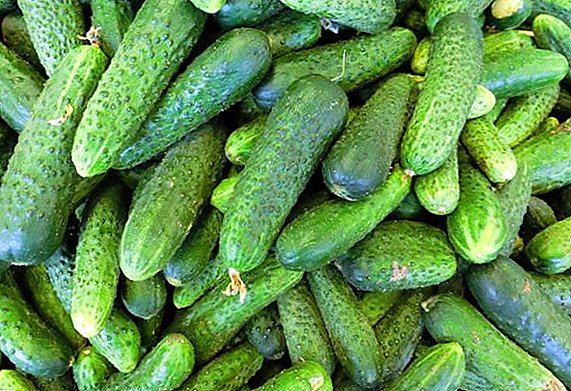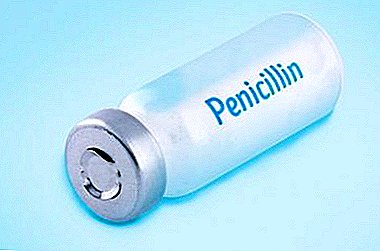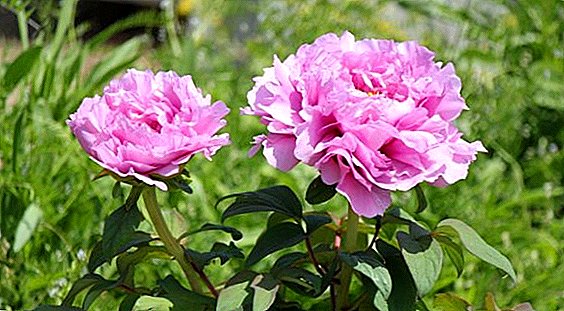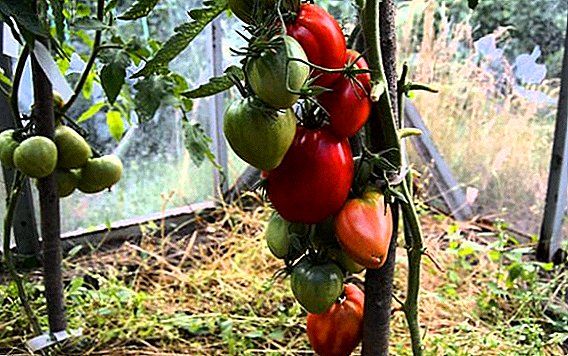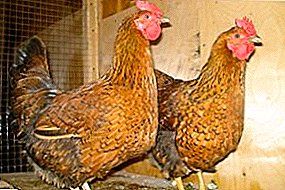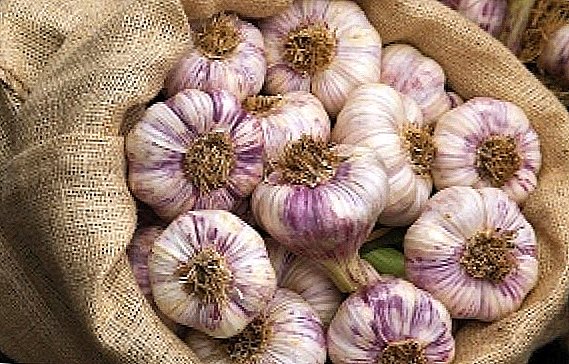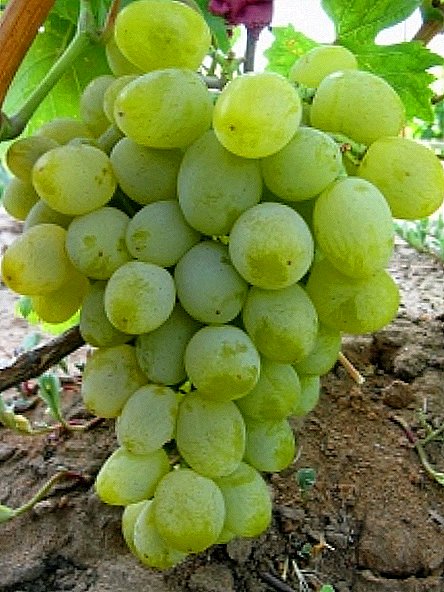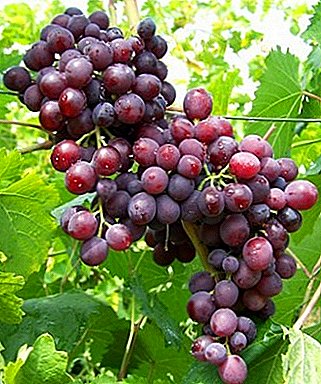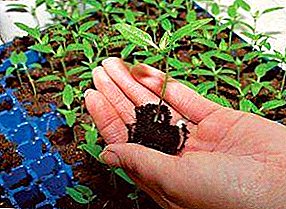
Eggplant - a very capricious culture, not easy for novice gardeners. Special tenderness is different seedlings.
So that it develops normally and in time forms the ovary, it is important to follow the rules of watering, feeding, and, of course, picks.
Timely transplant will allow seedlings to quickly start growing, accumulating vitality.
Today, the subject of the article is eggplants: growing seedlings, picking seedlings. How to dive eggplant seedlings? Is it possible to bury eggplants when picking?
Eggplant seedling picking: do you need it?
Most often, planting eggplants begins with sowing seeds in containers filled with nutrient substrate. After the plants unfold real leaves, they are carefully transferred to individual containers. Read more about seed preparation before sowing.
Next stage - transplanting to a greenhouse or garden bed. This scheme is suitable for most varieties, it has been tested many times and gives good results.
 Among arguments opponents of picks:
Among arguments opponents of picks:
- transfer weakens plants, many seedlings cannot recover after it and die;
- There are varieties that do not tolerate a pick;
- procedure causes additional inconvenience, lengthening the process of growing seedlings.
Proponents of the classical way emphasize that There are many advantages to picking:
- it stops the growth of seedlings allowing them to accumulate nutrients for the development of ovaries;
- when sowing in containers and subsequent picking weak plants can be rejected, saving space for strong seedlings;
- transplant at an early age hardens the plantsby enhancing their immunity;
- moving allows you to assess the state of the roots and take urgent action if necessary.
In order for the procedure to be beneficial, it is important to carry it out carefully, trying not to injure the delicate roots. Be sure to use drugs that support the immunity of seedlings and quickly heal random microtraumas.
Dates
When to dive eggplant seedlings? Most gardeners prefer diving plants when they unfurl the first pair of these sheets. At this time, the seedlings are quite strong and viable, they survive the transplant without any problems.
Moreover, at this time it is clear which eggplants are developing faster; it is they who can be preferred by rejecting frail sprouts. This approach is important for subsequent transplantation into small greenhouses with limited space.
Some experts recommend surgery before., immediately after the full unfolding of the cotyledon leaves. At this time, the roots of seedlings are very short, they are harder to damage.
 Young eggplants are taken out together with a lump of earth, which allows them to adapt more quickly to a new place.
Young eggplants are taken out together with a lump of earth, which allows them to adapt more quickly to a new place.
With the removal of one seedling, its neighbors are not damaged.. Reception is ideal for growing particularly valuable varieties.
Early picking does not harm plants, but young eggplants cannot linger in seedling containers. Roots can be intertwined, after which the seedlings can not be divided without injury. Overgrown roots easily break off, after which the plants may die.
Picking rules
How to dive eggplant seedlings? For young seedlings preparing a light nutrient primer from a mixture of garden soil with humus. The soil should be light, nutritious, with a neutral or slightly alkaline reaction. It is advisable to use the same soil that filled the containers for sowing seeds.
For young eggplants small pots made of plastic or thick paper will doIt is possible to use self-rolled containers. Too big pots can not be taken, the soil in them quickly sours, seedlings can get sick.
Peat cups also do not fit, fragile, weak roots of eggplants can not break through the dense walls of a mixture of peat with pressed cardboard. In addition, an excess of peat helps to increase the acidity of the soil, eggplants do not like it.
Before picking eggplants in a container need to water well. Then each seedling is gently hooked with a peg or a special narrow spatula.
If the central spine is too long, you can pinch it carefully. It is worth considering that such a procedure slightly delayed the growth of seedlings, so nipping shown only high, strong, well-developed seedlings.
 In a pot filled with soil, a hole is made into which the young plant is placed. It is important that the hole was deep enough, the roots should not bend.
In a pot filled with soil, a hole is made into which the young plant is placed. It is important that the hole was deep enough, the roots should not bend.
To help them deal, you can gently water the plant with warm water along the stalk. Deepening is moderate, up to cotyledon leaves. The hole is filled with soil, the surface of the soil is slightly crushed by fingers.
Final stage - dosed watering. Water should be warm, preferably boiled. You can use separated or rain water, as well as a solution of epin. A special drug enhances the immunity of seedlings, allowing them to quickly adapt to a new place.
The soil is sprayed abundantly from a spray bottle, you can use a fine-mesh watering can. After watering the soil sprinkled with a thin layer of peat. Potted seedlings are placed on a pallet and placed in a warm, well-lit place. In the first days they should be protected from drafts and direct sunlight.
After 10 days, the pickled seedlings can be fed with an aqueous solution of complex mineral fertilizer (a mixture of ammonium nitrate, potassium sulfate, superphosphate).
Transplant into the ground: little tricks
When the seedlings acquire 6-7 true leaves, it is time to transplant to a permanent place of residence. Young eggplants can be relocated to the greenhouse in mid-May; they are planted in the ground under the film closer to mid-June.. Much depends on climatic conditions.
 The soil should warm up well, whimsical eggplants will not tolerate even a slight drop in temperature.
The soil should warm up well, whimsical eggplants will not tolerate even a slight drop in temperature.
The ideal temperature for the soil - from 15 degrees, the air during the day should warm up to 18-20 degrees. Eggplants can be transplanted to heated greenhouses at any time.
Before moving seedlings it is important to prepare the ground. It is carefully loosened, the remains of plants and other extraneous inclusions are selected from the soil. A generous portion of old humus is introduced. If the soil is too acidic, you can neutralize it with dolomite flour.
To ease heavy loamy soil will help washed river sand or peat. For disinfection the soil is spilled with a hot solution of potassium permanganate or copper sulphate.
The surface of the soil is leveled, laid out holes about 12-15 cm deep. The distance between plants should not be less than 45 cm. For larger and spreading bushes, this gap can be increased.
For ease of caring for eggplants, 60-70 cm wide rows of rows are left. A handful of wood (preferably birch) ash is placed in each well. The day before planting the seedlings need to be watered abundantly.
It is better to transplant eggplants in the morning, in warm weather.. Plants are alternately removed from the individual containers along with a clod of earth.
IMPORTANT! Shaking off the soil from the roots is not necessary, you can not pull the seedlings over the stalks. The pot must be carefully turned over, effortlessly removing the plant.
Glasses made of cardboard or plastic can be notched, it will facilitate the notch.
The seedling with a clod of land is set in the hole. Strong deepening harms eggplants, they need to fill the ground just above the surface of the pots. The soil around the seedlings is slightly compacted. Plants are watered with warm water from small-cell watering can.
Pour water on the stems can notIt is recommended to moisten the soil around the eggplants liberally. After watering the soil is covered with peat. Such mulching will keep the moisture level at a normal level, weeds will not multiply.
 In the first days of the plant should be pritenyat from the hot sun. Planted in the ground cover the plastic film, fortified on the arcs.
In the first days of the plant should be pritenyat from the hot sun. Planted in the ground cover the plastic film, fortified on the arcs.
Young eggplants can be watered a week after transplantation; the first feeding will be needed no earlier than 2 weeks later.
Properly picked and transplanted seedlings in time is a guarantee of the normal development of eggplants and obtaining a bountiful harvest. It is important to carefully care for the displaced plants, so that the first, most difficult days they survive without problems, without delaying growth for a long time.
So, we looked at how eggplant seedlings are picked at home? Led the basic rules and some features diving eggplant seedlings.
Useful materials
Read other articles about growing and caring for eggplant seedlings:
- Different methods of cultivation: in peat tablets, in a snail and even on toilet paper.
- All features of sowing according to the lunar calendar.
- Golden rules for growing from seed.
- Features of cultivation in different regions of Russia: in the Urals, in Siberia and the Moscow region.


